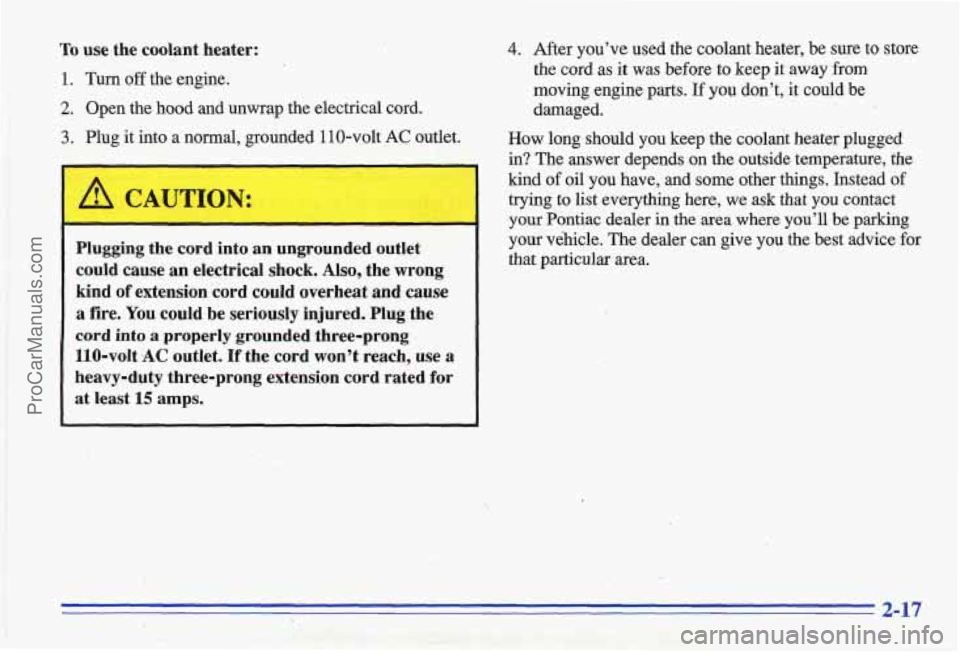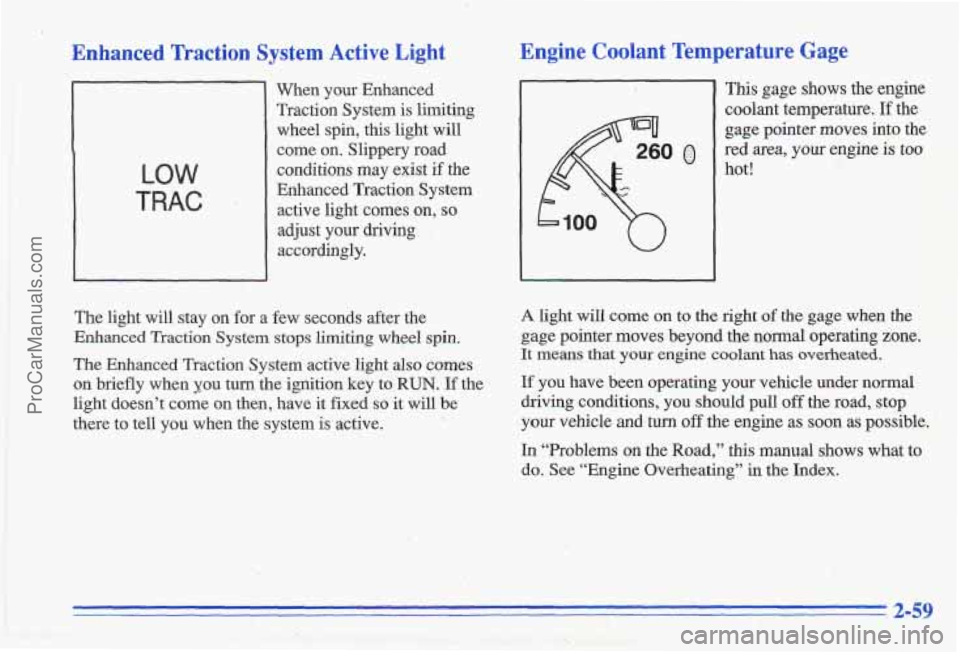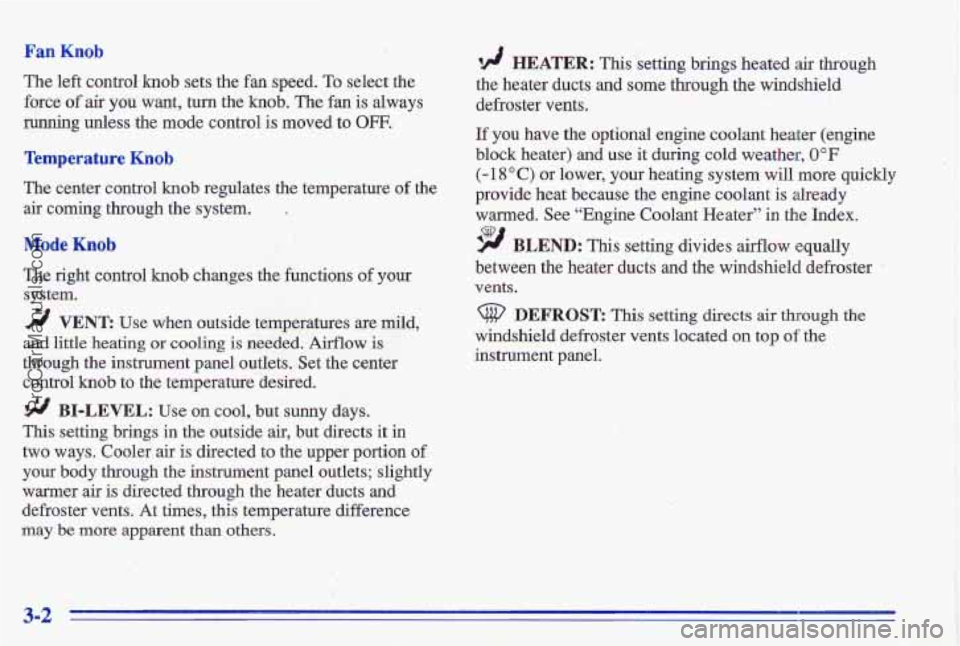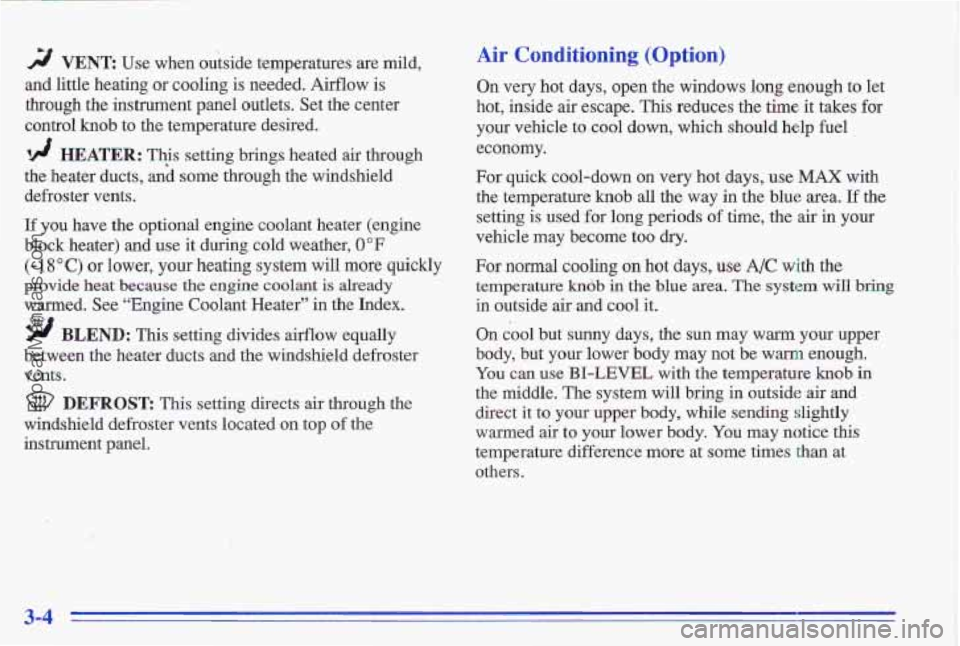1996 PONTIAC GRAND-AM engine coolant
[x] Cancel search: engine coolantPage 7 of 356

For example,
these symbols
me used on an
original battery:
POSSIBLE A
CAUTION
INJURY
PROTECT EYES BY
SHIELDING
CAUSTIC
ACID COULD BAllERY
CAUSE
BURNS
AVOID
SPARKS OR FLAMES
FLAME
EXPLODE BAllERY
These symbols
are important
for you and
yorr passengers
whenever your
vehicle is
driven:
DOOR LOCK
UNLOCK
FASTEN SEAT
BELTS
Vehicle Symbols
These are some of the symbols you may find on your vehicle.
Op
AIR BAG p
These symbols
have
to do with
your lights:
SIGNALS e
TURN
PARKING
pf
LAMPS
RUNNING
' ' 0
DAYTIME *
LAMPS *
FOG LAMPS $0
These symbols
are
on some of
your controls:
WINDSHIELD
DEFROSTER
WINDOW
DEFOGGER
VENTILATING FAN
These symbols are used on
warning and
indicator lights:
ENGINE k
COOLANT - rd
TEMP -
BRAKE (0)
ENGINE OIL
PRESSURE
ANTI-LOCK
(e)
BRAKES
Here are some
other symbols
you may
see:
FUSE
LIGHTER
m
HORN )tr
SPEAKER
b
il'
FUEL
V
ProCarManuals.com
Page 72 of 356

Engine Coolant Heater (Option)
2.4L Engine
c
c
I RI
3.1L Engine
In very cold weather, 0°F (- 18°C) or colder, the engine
coolant heater can help. You’ll get easier starting and
better fuel economy during engine warm-up. Usually,
the coolant heater should be plugged
in a minimum of
four hours prior to starting your vehicle.
2-16
ProCarManuals.com
Page 73 of 356

To use the coolant heater:
1. Turn off the engine.
2. Open the hood and unwrap the electrical cord.
3. Plug it into a normal, grounded 110-volt AC outlet.
1 A CAUTION:
Plugging the cord into an ungrounded outlet
could cause an electrical ,shock. Also, the wrong
kind
of extension cord could overheat and cause
a fire. You could be seriously injured. Plug the
cord into
a properly grounded three-prong
110-volt
AC outlet. If the cord won't reach, use a
heavy-duty three-prong extension cord rated for
at least 15 amps.
,-.. . . . 4.8 ..
4. After you've used the coolant heater, be sure to store
the cord as it was before
to keep it away from
moving engine parts. If you don't, it could be
damaged.
How long should you keep$he coolarit heater plugged
in? The answer depends on the outside temperature,
the
kind of oil you have, and some other things. Instead of
trying to list everything here, we
ask that you contact
yo" Pontiac dealer in the area where you'll be parking
your vehicle. The dealer can give you the best advice for
that particular area.
.. . i
ProCarManuals.com
Page 115 of 356

Enhanced Traction System Active Light
LOW
TRAC
When your Enhanced Traction System is limiting wheel spin, this light will
come on. Slippery road
conditions may exist
if the
Enhanced Traction System
active light comes on,
so
adjust your driving
accordingly.
The light
will stay on for a few seconds after the
Enhanced Traction System stops limiting wheel spin.
The Enhanced Traction System active light also comes
on briefly when you turn the ignition key to RUN. If the
light doesn’t come on then, have it fixed
so it will be
there to tell you when the system is active.
Engine Coolant Temperature Gage
This gage shows the engine
coolant temperature.
If the
gage pointer moves into the
red area,
your engine is too
hot!
A light will come on to the right of the gage when the
gage pointer moves beyond the normal operating zone.
It means that
your engine coolant has overheated.
If you have been operating your vehicle under normal
driving conditions, you should pull
off the road, stop
your vehicle and turn off the engine as soon as possible.
In “Problems on the Road,” this manual shows what to
do. See “Engine Overheating” in the Index.
2-59
ProCarManuals.com
Page 116 of 356

Low Coolant Warning Light
; I’ ,.
If this light comes on and
stays on, the vehicle should
be promptly pulled
off the
road and the coolant level
checked.
See “Engine
Coolant”
in the Index.
Malfunctilon Indicator Lamp
(Check Engine Light) ~ ..
0
CHECK
Your Pontiac is equipped
with a computer
which
monitors operation of the
fuel, ignition and emission
control systems.
If there are visible signs of steam see “Engine
Overheating” in the
Index before opening the hood. , . ’? --+ -- This system is called OBD I1 (On-Board .>. ’ I .;: . , Diagnostics-Second Generation) and is intended to
.-. . assure that emissions are at acceptable levels for the
life of the vehicle, helping to produce a cleaner
environment.
(In! Canada, OBD 11 is replaced by
Enhanced Diagnostics.) The CHECK ENGINE light
comes on to indicate that there is a problem and service
is required, Malfunctions often will
be indicated by the
system before
any problem is apparent, which may
prevent more serious damage to your vehicle. This
system is
also designed to assist your service technician
d . in correctly diagnosing any malfunction.
.. .? ’. .. .- . .. i - ,, , c < -. , ,. t :. . ‘7 -n. 9’ .! , . ‘i :- -:x: :, -’ ::;.- . b- .. ,- , . .. .. . : .. -. I. . :. ‘1 .’ ’ E -, . - . r_ :. .. . I. , I -.. . I .C . .. . . .. . .-..-‘ >: =: , , ‘. .. -; T‘.
’ ““2-60
ProCarManuals.com
Page 124 of 356

Fan Knob
‘The left controlknob sets the fin speed. To select thle
force
of air you want, turn the knob. The fan is always
runhing unless the mode control is moved to OFF.
Temperature Knob
The center control knob regulates the temperature of the
air coming through the system. ,
Mode Knob
The right control knob changes the functions of your
system.
2 VENT Use when outside temperatures are mild,
and little heating or cooling is needed, Airflow is
through the instrument panel outlets. Set the center
control
hob to the temperature desired.
9 BI-LEVEL: Use on cool, but sunny days.
This setting
brings in the outside air, but directs it in
two
ways. Cooler air is directed to the upper portion of
your body through the instrument panel outlets; slightly
wanner
air is directed through the heater ducts and
defroster vents. At times, this‘temperature difference
may be more apparent than others,
d HEATER: This setting brings heated air through
the he’ater ducts and some through the windshield
defroster vents.
If you have the optional engine coolant heater (engine
block heater)
and use it during cold weather, 0°F
(- 18 O C) or lower, your heating system will more quickly
provide heat be’cause the engine coolant is already
warmed. See “Engine Coolant Heater” in
the Index.
9 BLEND: This setting divides airflow equally
between the heater ducts
and the windshield defroster ’
vents.
DEFROST
This setting directs air though the
windshield gefroster vents located on top of the
instrument panel,
3-2
ProCarManuals.com
Page 126 of 356

rF/ VENT Use when outside temperatures are mild,
and little heating or cooling is needed. Airflow is
through the instrument panel outlets. Set the center
control
knob to the temperature desired.
‘!! HEATER: This setting brings heated air through
the heater ducts, aid some through the windshield
defroster vents.
If you have the optional engine coolant heater (engine
block heater) and use it during cold weather,
0°F
(- 1 8 O C) or lower, your heating system will more quickly
provide heat because
the engine coolant is already
warmed. See “Engine Coolant Heater”
in the Index.
9 BLEND: This setting divides aeflow equally
between the heater ducts and the windshield defroster
vents.
DEFROST This setting directs air through the
windshield defroster vents located on top of the
instrument panel.
Air Conditioning (Option)
On very hot days, open the windows long enough to let
hot, inside air escape. This reduces the time it takes for
your vehicle to cool down, which should help fuel
economy.
For quick cool-down on very hot days,
use MAX with
the temperature
knob all the way in the blue area. If the
setting is used for long periods
of time, the air in your
vehicle may become too dry.
For normal cooling on hot days, use A/C with the
temperature
kndb in the blue area. The system will bring
in outside air and cool it.
On cool but sunny days, the sun may warm your upper
body, but your lower body may not be warm enough.
You can use BI-LEVEL with the temperature knob in
the middle. The system will bring in outside air and
direct it to your upper body, while sending slightly
warmed air
to your lower body. You may notice this
temperature difference more at some times than at
others.
3-4
ProCarManuals.com
Page 127 of 356

Hc-4ing
‘lix---lg the right control knob to HEATER and the
center control
knob clockwise sends some heated air
through the heater ducts toward your feet and some
through the defroster vents.
Veri, 3ys1
Use when outside temperatures are mild, and little
heating or cooling is needed. Turn the right knob to
VENT. Airflow is directed through the instrument panel
outlets. Set the center knob to the temperature desired.
VENT and HEATER are economical positions because Your Pontiac’s flow-through ventilation system supplies
the air conditioner compressor doesn’t run in these two outs\
ide air into the vehicle when it is moving. Outside
settings. This reduces engine load, resulting in improved
air will also enter the vehicle when the heater or the air
fuel economy.
If either setting fails to keep you conditioning fan is running.
comfortable, or causes your windows to fog up, turn
the right control
knob to one of the air conditioning Adjust the direction of
positions, or to DEFROST. airflow by moving the
If
you have the optional engine coolant heater (engine
block heater) and use it during cold weather, 0 OF ,
(- 18 O C) or lower, your heating system will more
quickly provide heat because the engine coolant is
already
warmed. See “Engine Coolant Heater”
the Index. louvered vents.
3-5
ProCarManuals.com